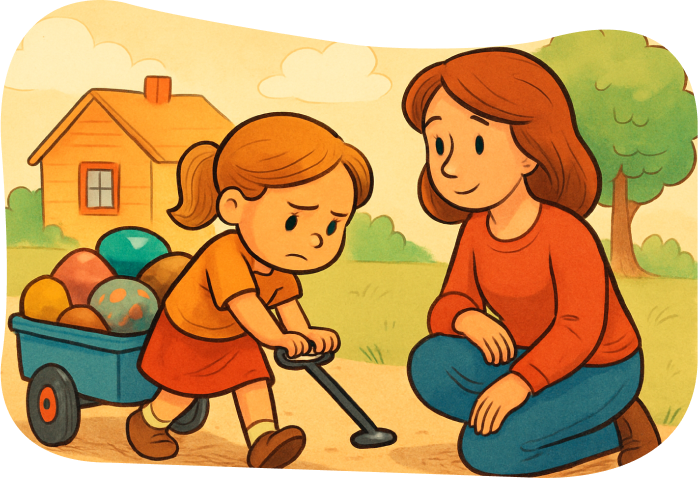
Featuring The Blue Wagon by Karen R. Sullivan
There’s an old saying that kids should be “seen and not heard.” For generations, that sentiment has lingered, echoing through classrooms, homes, and even children’s books. But what if the stories we tell kids actually heard them? What if, instead of teaching them to stay quiet, stories helped them speak?
In The Blue Wagon, debut author Karen R. Sullivan does exactly that. She offers a gentle yet powerful reminder that childhood is not just a prelude to adulthood—it’s its own rich, emotional landscape, deserving of respect, attention, and care.
At first glance, The Blue Wagon seems like a simple story. Six-year-old Heather pulls her empty blue wagon down the sidewalk in search of treasures. She finds rocks—beautiful ones, old ones, even one gifted by a kindly neighbor named Mr. Wiggledimp. By the time she returns home, her wagon is full.
But it’s more than just a story about a child collecting shiny objects. The wagon becomes a metaphor for the invisible burdens children carry. Some burdens are picked up voluntarily—out of curiosity, love, or excitement. Others, like worries and fears, sneak in unnoticed. As Heather grows tired from pulling the weight of her “treasures,” readers begin to understand: this is not just about rocks. It’s about what children carry emotionally, and what they wish the adults around them would notice.
Karen R. Sullivan writes from experience. As someone who spent years telling stories to her twin nephews, she understands how naturally children open up when they feel safe and seen. Her slogan—children deserve to be seen and heard—is more than just a tagline. It’s the philosophy behind every page.
“I wanted to remind adults to have more empathy for what children experience,” Sullivan says. “We often treat them like miniature adults, but they’re not. They need space to play, imagine, and express themselves without being burdened by the world’s heaviness.”
In Heather’s story, that message is crystal clear. When her mother initially brushes off her request to admire the treasures, Heather doesn’t throw a tantrum. She waits. She trusts. And eventually, her mother sits beside her, listening and sharing a moment of reflection. It’s one of the book’s quiet triumphs: a shared understanding that even the heaviest loads feel lighter when someone else is willing to carry them with you.
There’s an especially poignant exchange near the end of the book:
“Sometimes grown-ups don’t pull wagons, but they pull thoughts out of their heads. And those thoughts get heavy just like your rocks.”
This kind of dialogue is what makes The Blue Wagon more than just a picture book. It’s a children’s story packed with adult-sized emotions—perfect for sparking meaningful conversations between generations. Educators and parents alike will find it useful not just as a read-aloud, but as a way in.
Let’s talk about Mr. Wiggledimp for a second. He’s more than the whimsical old neighbor with a funny name. He’s a symbol of wisdom and intergenerational kindness. His rainbow-painted rock—dismissed by his own children but treasured by Heather—speaks volumes. What one person discards, another sees as priceless. And when he tells Heather, “It doesn’t matter how valuable they are to others—it only matters that they are valuable to you,” he isn’t just talking about rocks. He’s talking about feelings, memories, and self-worth.
In an era where kids are absorbing stress from every direction—school pressures, family dynamics, media overload—a book like The Blue Wagon creates a safe space. It says, “You don’t have to have it all figured out. You’re allowed to feel tired. And someone should listen.”
That message resonates far beyond age six. In fact, Sullivan admits that she originally imagined herself writing books for adults about the inner child. “But this book reached deeper than I expected,” she shares. “I realized it’s an inner child book disguised as a children’s book. It speaks to everyone from six to sixty.”
That’s the beauty of metaphor when it’s done right. A child sees a colorful rock. An adult sees what’s been left behind or unacknowledged for years. Both are right. Both find value.
From a craft perspective, Sullivan’s storytelling stands out for its lyricism and clarity. Her prose is rich without being overdone. The pacing is gentle, and the structure leaves space for young readers to absorb each moment. Illustrator collaboration aside, the emotional visuals are already vivid through words alone.
The Blue Wagon is more than a picture book. It’s a picture book about healing and hope, a story about kindness and the emotional burdens children carry, and an illustrated book on empathy. It’s about wagons and heavy loads, treasures, and what happens when we let kids show us what matters most to them.
Final Thought:
Stories like The Blue Wagon don’t shout. They don’t preach. They sit beside you quietly and say, “Let me show you something important.” And if we’re wise enough to listen, we’ll realize what Karen R. Sullivan already knows:
Children aren’t just watching us—they’re hoping we’ll watch them back.
Quick Links
Useful Links
Copyright © 2025 Karen Sullivan. All Rights Reserved.